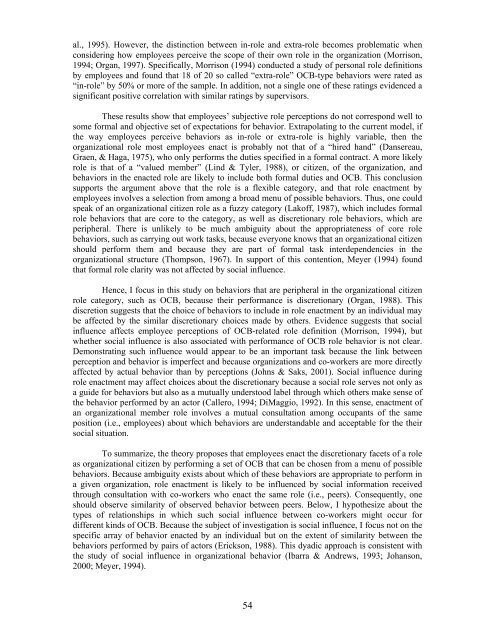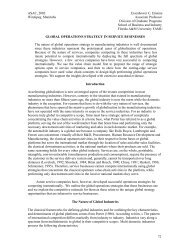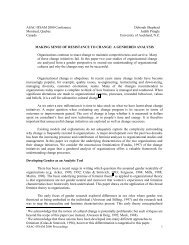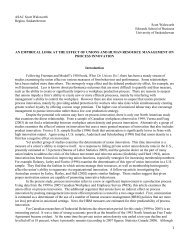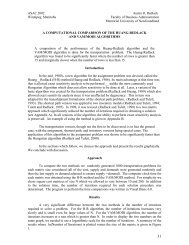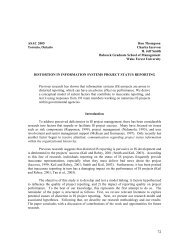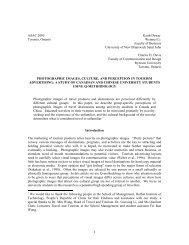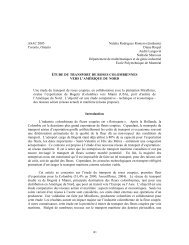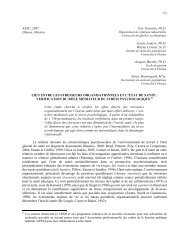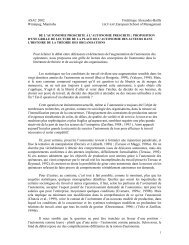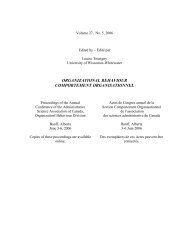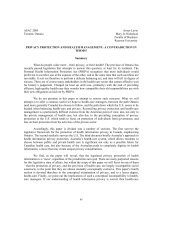al., 1995). However, the distinction between in-role and extra-role becomes problematic whenconsidering how employees perceive the scope of their own role in the organization (Morrison,1994; Organ, 1997). Specifically, Morrison (1994) conducted a study of personal role definitionsby employees and found that 18 of 20 so called “extra-role” OCB-type behaviors were rated as“in-role” by 50% or more of the sample. In addition, not a single one of these ratings evidenced asignificant positive correlation with similar ratings by supervisors.These results show that employees’ subjective role perceptions do not correspond well tosome formal and objective set of expectations for behavior. Extrapolating to the current model, ifthe way employees perceive behaviors as in-role or extra-role is highly variable, then theorganizational role most employees enact is probably not that of a “hired hand” (Dansereau,Graen, & Haga, 1975), who only performs the duties specified in a formal contract. A more likelyrole is that of a “valued member” (Lind & Tyler, 1988), or citizen, of the organization, andbehaviors in the enacted role are likely to include both formal duties and OCB. This conclusionsupports the argument above that the role is a flexible category, and that role enactment byemployees involves a selection from among a broad menu of possible behaviors. Thus, one couldspeak of an organizational citizen role as a fuzzy category (Lakoff, 1987), which includes formalrole behaviors that are core to the category, as well as discretionary role behaviors, which areperipheral. There is unlikely to be much ambiguity about the appropriateness of core rolebehaviors, such as carrying out work tasks, because everyone knows that an organizational citizenshould perform them and because they are part of formal task interdependencies in theorganizational structure (Thompson, 1967). In support of this contention, Meyer (1994) foundthat formal role clarity was not affected by social influence.Hence, I focus in this study on behaviors that are peripheral in the organizational citizenrole category, such as OCB, because their performance is discretionary (Organ, 1988). Thisdiscretion suggests that the choice of behaviors to include in role enactment by an individual maybe affected by the similar discretionary choices made by others. Evidence suggests that socialinfluence affects employee perceptions of OCB-related role definition (Morrison, 1994), butwhether social influence is also associated with performance of OCB role behavior is not clear.Demonstrating such influence would appear to be an important task because the link betweenperception and behavior is imperfect and because organizations and co-workers are more directlyaffected by actual behavior than by perceptions (Johns & Saks, 2001). Social influence duringrole enactment may affect choices about the discretionary because a social role serves not only asa guide for behaviors but also as a mutually understood label through which others make sense ofthe behavior performed by an actor (Callero, 1994; DiMaggio, 1992). In this sense, enactment ofan organizational member role involves a mutual consultation among occupants of the sameposition (i.e., employees) about which behaviors are understandable and acceptable for the theirsocial situation.To summarize, the theory proposes that employees enact the discretionary facets of a roleas organizational citizen by performing a set of OCB that can be chosen from a menu of possiblebehaviors. Because ambiguity exists about which of these behaviors are appropriate to perform ina given organization, role enactment is likely to be influenced by social information receivedthrough consultation with co-workers who enact the same role (i.e., peers). Consequently, oneshould observe similarity of observed behavior between peers. Below, I hypothesize about thetypes of relationships in which such social influence between co-workers might occur fordifferent kinds of OCB. Because the subject of investigation is social influence, I focus not on thespecific array of behavior enacted by an individual but on the extent of similarity between thebehaviors performed by pairs of actors (Erickson, 1988). This dyadic approach is consistent withthe study of social influence in organizational behavior (Ibarra & Andrews, 1993; Johanson,2000; Meyer, 1994).54
Social Influence MechanismsBecause social influence is argued to occur through consultation among colleagues, itmust involve a contagion process: resource exchange and communication between people(Johanson, 2000). Contagion may be associated with two different types of social influencemechanism: Direct social influence between two actors and indirect social influence that resultsfrom two actors interacting with the same third parties (Johanson, 2000; Shah, 1998). Directsocial influence is likely to occur between actors who are involved in a mutual relationshipbetween them (Friedkin, 1984). In the context of such a relationship, two actors directly exchangesocial cues or persuasive messages that influence each other’s interpretation of what rolebehaviors are appropriate and how frequently they should perform these behaviors. Indirectinfluence occurs when two social actors maintain relationships to the same other actors, a socialmechanism known as structural equivalence (Burt, 1976). Structurally equivalent actors mayperform similar behaviors because they receive similar social cues about appropriate rolebehaviors and performance through the indirect interaction between them that arises by virtue ofmaintaining relationships to the same set of third party actors. Thus, they receive the same socialinformation from others but do not necessarily transmit cues directly between them.Social influence through contagion may also differ depending on the form of relationshipin which colleagues interact and communicate with each other. The context of the relationship isimportant because it designates the type of social resources that are exchanged among actors and,hence, may raise the salience of different role behaviors that are subject to social influence. Thereare two generic types of relationships among individuals in organizations that form two differentsocial networks (Ibarra, 1992; Lincoln & Miller, 1979). Instrumental relationships designate anetwork of interactions for the purpose of exchanging work-related resources and information,while expressive relationships designate a network of associations on the basis of friendship andsocial affiliation. The question thus arises: What types of social influence effects on OCB mightexist in these two different networks?An established distinction made in the OCB literature is between interpersonal OCB andcollective OCB. This distinction is based on the intended beneficiary of a particular behaviorperformed by an organizational member (Podsakoff et al., 2000; Williams & Anderson, 1992).On the one hand, interpersonal OCB are targeted at individual actors, facilitate interactionsamong individuals, and encourage morale and cooperation among individuals (Borman &Motowidlo, 1993; Podsakoff et al., 2000). Interpersonal OCB are exchanged between employeesand contribute indirectly to organizational effectiveness by supporting the social context in whichemployees perform their tasks. These behaviors may include giving help to one’s co-workers orassisting interpersonal cooperation among employees. On the other hand, collective OCB aretargeted at an impersonal beneficiary, the organization in general, and are tendered in more directexchange to contribute to the collective as a whole (Podsakoff et al., 2000; Van Dyne et al.,1995). These behaviors constitute contributions to the effective functioning of the organizationalsystem and include such behaviors as participating in committees or making innovativesuggestions (Organ, 1988). Based on the distinctions between different types of social networkrelationships and between different classes of OCB, several simple predictions can be made.The first prediction is that interpersonal OCB should be most subject to direct socialinfluence in mutual expressive relationships. This prediction is premised on the idea from socialinformation processing theory (Salancik & Peffer, 1978) that behaviors which benefit a specificother individual and are designed to support a cooperative interpersonal context should be madesalient by interactions that involve the interpersonal exchange of friendship and social support.Furthermore, because interpersonal OCB and expressive relationships both focus on personalexchanges, social influence is likely to derive from a mechanism that unfolds directly betweenactors rather than indirectly through widely shared social definitions of organizational reality(Johanson, 2000). Thus, interpersonal exchange processes between individuals are likely to give55
- Page 1 and 2:
Volume 24, No. 5, 2003Edited by/Éd
- Page 4 and 5:
Pursey HeugensGreg IrvingRoderick I
- Page 6 and 7:
TABLE OF CONTENTS - TABLE DES MATI
- Page 8 and 9:
study of power displays in mixed-ge
- Page 10 and 11: on expectations and behaviour (Berg
- Page 12 and 13: TaskThis study required the use of
- Page 14 and 15: Task-Gender (male-stereotyped or fe
- Page 16 and 17: It is important to understand the s
- Page 18 and 19: Crown, C.L. & Cummins, D.A. (1998).
- Page 20 and 21: Smith-Lovin, L., & Brody, C. (1989)
- Page 22 and 23: Table 2Summary of Descriptive Stati
- Page 24 and 25: Table 4Summary of Interaction of Ge
- Page 26 and 27: ASAC 2003Halifax, Nova ScotiaIain L
- Page 28 and 29: the interrelationships among the MB
- Page 30 and 31: studies (Friedman and Sarros, 1989;
- Page 32 and 33: This study demonstrated that emotio
- Page 34 and 35: Anxiety, Stress and Coping, in pres
- Page 36 and 37: Washington, DC: Taylor and Francis,
- Page 38 and 39: Table 2Overall Goodness-of-Fit Indi
- Page 40 and 41: ζ 3Depersonalizationη 3β 3,1 (+)
- Page 42 and 43: ASAC 2003Halifax, Nova ScotiaWendy
- Page 44 and 45: views independently, gave rise to S
- Page 46 and 47: track assistant, associate, and ful
- Page 48 and 49: ole conflict are positively related
- Page 50 and 51: Table 3. Regression of climate and
- Page 52 and 53: interests.We speculate the null eff
- Page 54 and 55: DOOP and short for DOOP scales,”
- Page 56 and 57: Pelled, L. H., “Demographic diver
- Page 58 and 59: esulting increase in discretion ove
- Page 62 and 63: ise to strong pressures for conform
- Page 64 and 65: presented with a complete list of a
- Page 66 and 67: Table 3QAP Regression Coefficients
- Page 68 and 69: ConclusionResearchers of social inf
- Page 70 and 71: suggestions for further research.
- Page 72 and 73: performing on the job.” Presumabl
- Page 74 and 75: positively related to performance i
- Page 76 and 77: proposed hypotheses were supported.
- Page 78 and 79: ConclusionThis research has made se
- Page 80 and 81: Be more enthusiastic and exert extr
- Page 82 and 83: Table 2Correlations Among the Laten
- Page 84 and 85: performance expectations on feedbac
- Page 86 and 87: changements qui s’opèrent dans l
- Page 88 and 89: structures, politiques, systèmes,
- Page 90 and 91: comportements liés à la communica
- Page 92 and 93: Tableau 2Échelles de mesure de la
- Page 94 and 95: prédiction des compétences clés
- Page 96 and 97: organisation n’est pas uniforme e
- Page 98 and 99: complètement ce construit. Ces cha
- Page 100 and 101: Wagner, R.K. and Sternberg, R.J. (1
- Page 102 and 103: What is a toxin handler?In two arti
- Page 104 and 105: potentially limited scope and conte
- Page 106 and 107: work role demands. In this survey,
- Page 108 and 109: The three factors in this rotated f
- Page 110 and 111:
and service orientation, the abilit
- Page 112 and 113:
ASAC 2003Halifax, Nova ScotiaLisa M
- Page 114 and 115:
self-appraisal group reacted more n
- Page 116 and 117:
effect of voice are the value-expre
- Page 118 and 119:
“Strongly Disagree” to “Stron
- Page 120 and 121:
esults suggest that incorporating s
- Page 122 and 123:
Personality and Social Psychology,
- Page 124 and 125:
Table 1Means, Standard Deviations,
- Page 126 and 127:
Table 3Test of the Mediating Role o
- Page 128 and 129:
ASAC 2003Halifax, Nova ScotiaAnn Fr
- Page 130 and 131:
individual level, polychronicity is
- Page 132 and 133:
construct.Drawing on computer-media
- Page 134 and 135:
Consequence: Impact on Work Overloa
- Page 136 and 137:
Conversation complexity may also mo
- Page 138:
Implications for practiceFuture res
- Page 141 and 142:
ReferencesAncona, D.G., Goodman, P.
- Page 143 and 144:
no. 3 (1994): 381-391.Macan, T.H.,
- Page 145 and 146:
ASAC 2003Halifax, Nova ScotiaIan R.
- Page 147 and 148:
Assessing Measures: Affective Commi
- Page 149 and 150:
implications of psychological contr
- Page 151 and 152:
commitment, affective commitment, c
- Page 153 and 154:
Motivational Process Variables. Amo
- Page 155 and 156:
DiscussionThe main purpose of this
- Page 157 and 158:
approaches zero. In the present stu
- Page 159 and 160:
Extension and test of a three-compo
- Page 162 and 163:
Table 1Descriptive Statistics and Z
- Page 164 and 165:
Table 3Standardized Factor Loadings
- Page 166 and 167:
Table 5Hierarchical Regression Anal
- Page 168 and 169:
ASAC 2003Halifax, Nova ScotiaJoan F
- Page 170 and 171:
ASAC 2003Halifax, Nova ScotiaArla D
- Page 172 and 173:
ASAC 2003Halifax, Nova ScotiaIvy Ky
- Page 174:
ASAC 2003Halifax, Nova ScotiaNina D


